The photo on the front page of the Washington Post said it all on the day after Ireland’s landmark same-sex marriage referendum. Two elderly Carmelite nuns in full habits were pictured leaving their polling place in Malahide, not far from Dublin. The caption read: “Roman Catholic leaders have led the opposition, but opinion polls signaled approval.”
Indeed, when the ballots were counted more than 60% of Irish voters agreed that “marriage may be contracted in accordance with law by two persons without distinction as to their sex.” Many people think the vote heralds the end of the Roman Catholic Church as we know it—but I think the reality might be more complicated.
I interpreted the Post’s photo of the nuns in all of its wonderful ambiguity. I assumed that the sisters had voted ‘yes.’ They are not church leaders, but lay people who surely understood discrimination when it was placed before them. I imagined that after decades in the same order they might even want to marry each other—or not! Given the scandalous way the Vatican has been acting with nuns of late, the old joke “the Bride of Christ wants a divorce” might be relevant. In any case, the people voted ‘yes’ to marriage equality and the world is better for it.
But does that mean the institutional church is out of business? No one knows. It certainly won’t go without a struggle. In fact, the “leaner meaner” church of Pope Benedict XVI could come roaring back with a vengeance.
We do know for sure that good Irish Catholics followed their faith in the direction of inclusion, compassion, equality, justice, and a host of other Catholic values when they voted with the majority despite some clergymen’s efforts to lead them astray. The hard sell for “no” from a group of bishops was all but ignored. Some clergy were public about their “yes” vote, and my guess is that more than a few gay priests (and some straight ones, too) voted for their own self-interest. Generations of Irish Catholics showed what they are made of.
Some of the most effective social media around the vote featured families of LGBTIQ Catholics. Their simple statements of love for their children and their hope that they might marry and form good Irish families were persuasive. It was all rather traditional in the end—everyone is entitled to love. While the institutional church lost miserably, the enduring message of post-Vatican II Catholicism—that all persons are equal with corresponding rights and responsibilities—had a good day. The fact that this message was distilled from the rubble of sexual abuse, clergy cover-up, heterosexism, disdain for women, and the rest of the clerically-constructed system is a miracle in itself. The pulpits are still in the hands of the priests, though, and they do not show many signs of sharing.
Dublin Archbishop Diarmuid Martin had the good sense to recognize that the vote was not trivial: “The church needs to take a reality check… It’s very clear there’s a growing gap between Irish young people and the church, and there’s a growing gap between the culture of Ireland that’s developing and the church.”
While his timing might be a few decades late, form follows function. Religions are living things, networks of relationships linked backwards with tradition and forward with hope. As Irish-American moral theologian Daniel C. Maguire has famously posited, “the renewable moral energy of religion” is a natural resource. It is on full display in Maguire’s mother Cassie’s native soil and I dare hope she would be proud
Many Irish Catholics, both on the isle and in diaspora, are so heartily sick of the institution’s duplicity, game playing, and pomposity that we would probably vote against the institutional Church on the value of chocolate ice cream. The recurring Irish debates on abortion will give way to another referendum before too long. I suspect the hierarchy, wounded but not slain, will mount another nasty campaign—and hopefully experience another comeuppance.
Irish clergy used to make a living telling other people how to live their lives no matter how flawed their own were. A generation ago people in Ireland went to daily mass after work and heard the messages repeated ad nauseam. Irish Catholics proved they know how to separate the wheat from the chaff, the important values like love and justice from warped attempts to dictate outmoded morality.
It is for lay Catholics around the world to be clear, as Irish voters were, that we can and will make our own decisions.
Much remains to be done to dismantle deeply entrenched structures. But the Irish referendum means that a top-down, clergy-heavy model of church heard its death knell in Dublin. As it reverberates around the world the Gospel message might get a little more airtime. As the Irish say, it will make a glass eye cry—with joy.





